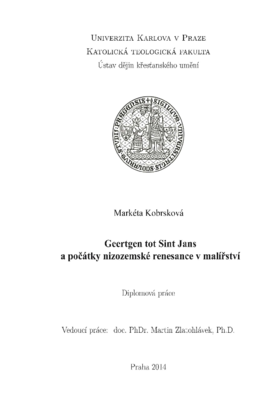Geertgen tot Sint Jans a počátky nizozemské renesance v malířství
Geertgen tot Sint Jans and the begining of Dutch Renaissance painting
diplomová práce (OBHÁJENO)

Zobrazit/
Trvalý odkaz
http://hdl.handle.net/20.500.11956/67593Identifikátory
SIS: 127256
Kolekce
- Kvalifikační práce [2276]
Autor
Vedoucí práce
Oponent práce
Jarošová, Markéta
Fakulta / součást
Katolická teologická fakulta
Obor
Dějiny křesťanského umění
Katedra / ústav / klinika
Ústav dějin křesťanského umění
Datum obhajoby
23. 1. 2015
Nakladatel
Univerzita Karlova, Katolická teologická fakultaJazyk
Čeština
Známka
Velmi dobře
Klíčová slova (česky)
Geertgen tot Sint Jans, Triptych s Klaněním tří králů, sbírky Pražského hradu, nizozemská renesance, Národní galerie v Praze, ikonografie, malbaKlíčová slova (anglicky)
Geertgen tot Sint Jans, The Triptych with The Adoration of the Kings, Prague Castle Collections, The National Gallery in Prague, Dutch Renaissance, iconography, paintingV diplomové práci se snažím o zařazení malíře Geertgena tot Sint Jans v kontextu počátku nizozemské renesance. Dále se zabývám jeho životem a dílem. Součástí práce je rozbor díla Triptychu s Klaněním tří králů ze sbírek Pražského hradu se zaměřením na umělecké vlivy a možnou inspiraci tvorbou Alberta van Ouwatera. Triptych s Klaněním tří králů je významné dílo nejen nizozemské, ale i evropské malby konce 15. století. Bohatý symbolický aparát ho spojuje se středověkou tradicí, ale zároveň v díle můžeme nalézt počátky iluzivní malby.
This diploma thesis deals with the life and work of the Dutch painter Geertgen tot Sint Janse in the context of the beginning of Dutch Renaissance. This diploma thesis contains an analyses of Triptych with The Adoration of the Kings from the Prague Castle Collections. In particular, the art influences and the possible inspiration by the work of Albert van Ouwater is discussed. The Adoration of the Kings is an important piece of art not only in the context of Dutch Renaissance painting but also in the context of European Renaissance at the end of 15th century. The rich symbolic apparatus of the tryptich refers to the medieval tradition, but the beginning of illusionism can be recognised from the painting as well.
